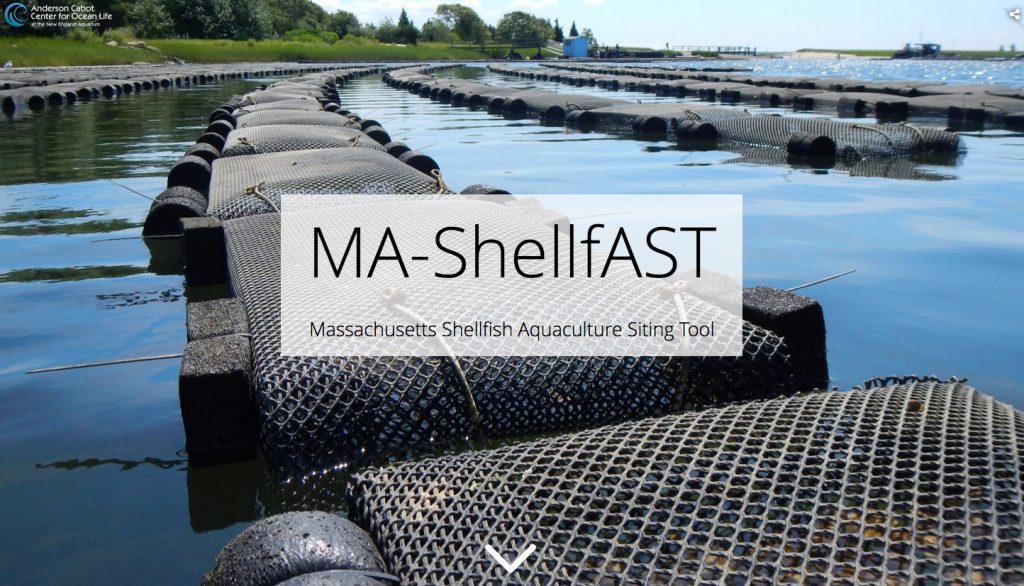Setting ‘Sites’ for Aquaculture

New GIS-based tool can help aquaculture industry grow
The simple pleasure of digging for clams and oysters is part of the fabric of life in New England. But for those wanting to make a living from growing shellfish – or those who license and monitor it – the process for selecting and establishing a farm can be complicated and daunting.
A new online aquaculture siting tool called MA-ShellfAST stands to change much of this, simplifying the process both for growers and regulators. Launched in the summer of 2018 and available for free online (at https://mass-eoeea.maps.arcgis.com/apps/Cascade/index.html?appid=6a7c6d1fc6de4359bb5379de4f4ce073), MA-ShellfAST provides Massachusetts growers and agencies with a geographic information system (GIS) that presents relevant environmental, legal, and municipal data in layers in a map-based format.

“Locating a new shellfish farm can be challenging,” says Woods Hole Sea Grant Extension Agent Diane Murphy. “Numerous permits must be obtained, and there are legal and regulatory issues to take into consideration -- state and federal laws, programs for protected species and protected areas, and coastal zone management, water quality, and public health concerns. Added to that, regulations may vary from town to town.”
MA-ShellfAST assists growers in understanding the regulatory requirements, potential conflicts, and biophysical characteristics of a given site before applying for approval for that site. It also enables them to draw a map of their proposed site to submit with their application.
From the state and municipal regulators’ perspective, the tool enables them to rapidly assess a shellfish farming application and quickly determine the types and severity of conflicts that may arise from the proposed work and the permits and consultations that are likely to be required.
In developing MA-ShellfAST, the project team assembled a multi-stakeholder advisory board that included representatives from federal, state and local government agencies, industry, and non-governmental organizations. The advisory board provided input and feedback on the components essential to making the tool truly useful.
“The coastal waters of Massachusetts where shellfish are harvested and grown are some of the most heavily utilized and economically, socially, and culturally important shared spaces in the Commonwealth,” says Advisory Board member Chris Schillaci, Aquaculture and Propagation Project Leader with the Massachusetts Division of Marine Fisheries (DMF). “As a result there is a tremendous focus from the public, the aquaculture industry, and the regulatory community to ensure future growth in the industry occurs in a way that is compatible with the environment and other marine user groups.”
The Tool
The tool comprises multiple data layers that allow users to filter map views depending on the parameters they are interested in, such as user conflicts, environmental impacts, permitting requirements, and availability of needed infrastructure such as boat ramps. All layers contain clickable pop-up information explaining what the data layer is, any pertinent information it may contain in relation to shellfish aquaculture siting, with links to relevant sections of background reports the team generated on specific topics.
One thing that sets this tool apart from products used in other states is the inclusion of regulatory information specific to each town. Because Massachusetts is a home-rule state, aquaculture siting regulations vary from town to town.
“Town ordinances have important differences on aspects like residency requirements, plot sizes, and whether barges or floating gear can be used,” says Read Porter. “This is the first time this critical information has been collected for every Massachusetts coastal municipality, allowing growers to easily evaluate whether they qualify and if their planned operation is feasible.”
And, Murphy points out, “This benefits not only those who are actively seeking a permit, but could benefit towns that are just getting into shellfish aquaculture and have yet to establish regulations.”
The team believes MA-ShellfAST can also be used to assist towns in the process of identifying and pre-permitting large areas that are suitable for shellfish aquaculture or what are known as Aquaculture Development Areas (ADAs). Once a town had obtained all the appropriate state and federal permits for an entire area, it can then accept applications from interested individuals for plots within the aquaculture zone. “ADAs can really simplify and hasten the permitting process for growers and help expand shellfishing in Massachusetts,” says Murphy.
Testing
An early version of the tool was presented and tested in Falmouth and Gloucester -- two towns with different levels of experience with shellfish aquaculture. Falmouth has well-established aquaculture licensing regulations and active aquaculture businesses in town waters; Gloucester has not developed shellfish aquaculture licensing regulations and recently accepted its first application for an aquaculture site in town waters. The testers included regulators and growers who were trained to use the tool and tested it over a period of several weeks. “Their feedback and suggestions for improvement were really valuable,” says Murphy.
“This tool is going to be really helpful to us locally,” says Falmouth Shellfish Constable Chuck Martinsen, who participated in the pilot testing. “It’s going to save people a lot of time. Instead of having to run around gathering information from lots of different people – the harbormaster, the GIS mapper, etc. – prospective shellfish farmers can find that information on the tool. And by the time they come in to talk to me about it, hopefully the spot they’re looking at is a bit more fine-tuned.”
With Massachusetts shellfish aquaculture valued at $28 million and counting, the demand for new farms is on the rise. MA-ShellfAST stands to be a go-to resource for those considering getting into the industry as well as those who regulate it. Woods Hole Sea Grant and the Cape Cod Cooperative Extension plan to introduce the tool and provide training in how to use it in the popular “Fundamentals of Shellfish Farming” class offered each spring.

